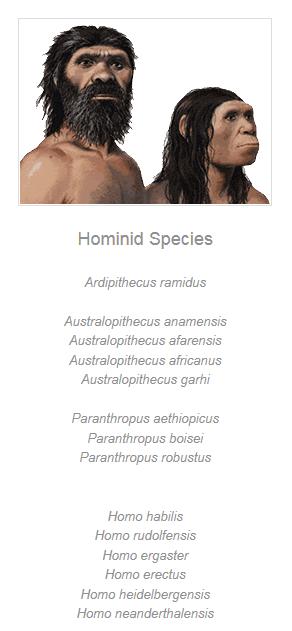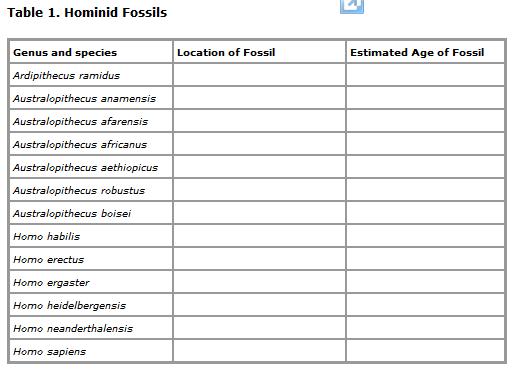humans as primates webquest
|
Introduction
Have you ever visited the primate house at a local zoo or watched a television program about primates? Many people are amused at the antics of gorillas,chimpanzees, monkeys, and lemurs as they eat, play, and explore. Did you know that humans are primates, too? All primates have opposable thumbs, a relatively large brain, good binocular vision, and flexible joints. Theearliest primates were prosimians, a group that includes present-day lemurs. Humanlike primates were called anthropoids. Present-day anthropoids include the monkeys and the hominids—apes and humans. Although humans, gorillas, and chimpanzees are close cousins genetically, humans did not evolve from the great apes. Instead, humans and apes probably evolved from a common ancestor between 8 and 5 million years ago. These two different groups formed the hominids – primates that can walk upright on two legs. Whereas the apes continued to evolve into the gorillas, chimpanzees, bonobos, orangutans, and gibbons of today, humans followed a different path. What hominids were the ancestors of present-day humans? How long ago did human ancestors split off from the rest of the hominids? Where did humans first evolve? Why is there just one species of humans alive today? These are some of the questions you will explore in this WebQuest on hominid fossils. |
Task
Your job in this WebQuest is to learn all about the evolution of humans. You will learn about the earliest hominids that may be part of the evolution of humans, and about the fossils that have been found which support this idea. You will look at photographs of these fossils and read about their similarities and differences. You will find out how scientists have pieced together the story of human evolution, and discover that the story is far from complete. You will
fill in a table that lists which hominids play a part in human evolution. Finally, you will answer a few questions about hominid fossils to demonstrate what you have learned in your Internet research.
Resources
Look at the web sites given here to find the information that will enable you to complete your table on hominid fossils and answer a few questions.
Process
Now that you have completed your research on hominid fossils, prepare a table like the one below with the information that you have gathered on each of the species listed. For each species, list the location in which the first fossils of its type were found and the estimated age of that fossil. You will need to look at all of the web sites listed in order to complete the table. Once the table has been filled in, answer the questions that follow.
Your job in this WebQuest is to learn all about the evolution of humans. You will learn about the earliest hominids that may be part of the evolution of humans, and about the fossils that have been found which support this idea. You will look at photographs of these fossils and read about their similarities and differences. You will find out how scientists have pieced together the story of human evolution, and discover that the story is far from complete. You will
fill in a table that lists which hominids play a part in human evolution. Finally, you will answer a few questions about hominid fossils to demonstrate what you have learned in your Internet research.
Resources
Look at the web sites given here to find the information that will enable you to complete your table on hominid fossils and answer a few questions.
- Prominent Hominid Fossils. Visit this site for a comprehensive listing of all hominid fossils that are important either for their scientific or historic interest. Scroll down and click on any photo to see a larger image and a description of the fossil.
- The Evidence: Hominid Fossils. Go to this University of Texas site to learn about the more important hominid fossils and what they can tell us about the evolution of humans. This is a very interesting site.
- The Fossil Evidence for Human Evolution in China. At this site you can learn about recent discoveries
in China that provide new evidence about human evolution. Click on the skull to read the article. - Human Evolution. Visit this site to see a proposed chart of human evolution from 5 million years ago to the present. This chart illustrates the best fit for known fossil specimens to date, but it is not accepted totally. As new fossils are found, they tend to impact thoughts about human evolution.
- Human Evolution: The fossil evidence in 3D.
Go to this site for an interactive comparison of the crania of five modernand five fossil primates. You will need shockwave plugin (available here) to view the gallery. Hold down the lefthand button on your mouse and move the cursor over each photograph to see the front and side views of each cranium.
- A Science Odyssey: You Try It: Human Evolution Activity. At this site you can use your mouse to move
through a timeline of human evolution. You can stop at any time from 5 million years ago to the present to learn about the hominid species that may, or may not, be a part of human ancestry - Early Human Evolution. Visit this site by Palomar College, San Marcos, California for an online course on human evolution. Click on early transitional humans to learn more about the earliest hominid species. Then scroll down and click on nest topic to read more about Homo erectus.
- Human Ancestry: Species. Go to this site to see a timeline with the hominid species from each time period. Click on any highlighted species name to read a short article about that species. This is a very detailed and excellent site.
- Early Human Phylogeny. At this Smithsonian Institution site you can see another timeline showing the evolution of hominids over the last 5 million years. Scroll down and click on any species name to learn more about that species. Or you can click on catalog to see a particular specimen in the National Museum of Natural History’s collection.
- New Hominid Species Complicates Early Hominid Evolution. Visit this site to read about a 3.5 million-year-old skull found in Kenya in 1998-1999. This skull is a new species called Kenyanthropus platyops. It is strikingly different from Australopithecus afarensis fossils from the same place and time period.
- In the Beginning: Humans and Environmental Change. Go to this site to learn more about the environmental changes that led to hominid evolution in Africa and beyond.
- Guided Tour – Hominid Evolution. At this site you can learn about the earliest hominids and see photographs of the fossils. You can also learn more about associated topics, such as bipedalism, at this site.
Process
Now that you have completed your research on hominid fossils, prepare a table like the one below with the information that you have gathered on each of the species listed. For each species, list the location in which the first fossils of its type were found and the estimated age of that fossil. You will need to look at all of the web sites listed in order to complete the table. Once the table has been filled in, answer the questions that follow.
Questions about Hominid Fossils
- A new species named Kenyanthropus platyops was found recently in Kenya. Between what two species would you place this species in the above table, and why?
- Another new species was discovered in Ethiopia in 1999. What is the genus and species of this fossil? Where would you place it in the above table?
- Name three of the clear trends in the evolution of hominids from early australopithecines to recent humans. For example, one clear trend is increasing brain size.
- Which step in hominid evolution came first – bipedal locomotion or larger brains? How do scientists know this?
- What happened about 8 to 5 million years ago in Africa that may have led to the development of many different species of hominids?
- Why are Neanderthals sometimes given the name Homo sapiens neanderthalensis?
- Why is there still so much controversy over the evolution of humans from hominids
- In your opinion, do you think they lived in the same region and is there a possibility that they interacted with each other?


